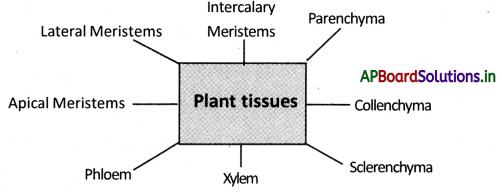Students can go through AP State Board 9th Class Biology Notes Chapter 2 Plant Tissues to understand and remember the concept easily.
AP State Board Syllabus 9th Class Biology Notes Chapter 2 Plant Tissues
→ Tissue is a group of cells similar in structure and performing similar functions.
→ Tissues that bring about overall growth and repair are called Meristematic Tissues.
→ Tissues that form outer coverings are called Dermal tissues.
→ Tissues that form the bulk of the plant body, helping in packing other tissues are called Ground tissues.
→ Tissues that help in the transport of materials are called Vascular tissues.
→ Meristematic tissue is of three types.
- Apical Meristem
- Lateral Meristem
- Intercalary Meristem.
→ The epidermis, Mesodermis, and Endodermis are formed from dermal tissues.
→ The dermal layer protects the plant from loss of water, mechanical damage, and diseases
→ Gum is secreted from the dermal layer.
→ Ground tissue is divided into three types.
- Parenchyma
- Collenchyma
- Sclerenchyma.
→ Parenchyma containing chloroplasts is chlorenchyma, with air cavities is Aerenchyma and that stores food is storage tissue.
→ The cells of the parenchyma are soft, thin-walled, and loosely packed
→ Collenchyma tissues have thicker walled large cells compared to the parenchyma.
![]()
→ In sclerenchyma, the cells are thick-walled and compactly arranged with nearly no intercellular spaces between them.
→ Nehemiah Grew give the term parenchyma for the pithy part
→ Vascular tissues are involved in transportation.
→ Vascular tissues are the xylem and phloem.
→ Xylem conducts water and mineral salts from the root, while phloem transports food I materials from leaves to the growing region.
→ Xylem consists of tracheids, vessels, fibers, and xylem parenchyma.
→ Phloem consists of sieve cells and sieve tubes, companion cells, phloem fibers, and phloem parenchyma.
→ Xylem carries water up to 200ft in Eucalyptus and up to 330ft in Redwood trees.
→ Tissue: A group of cells similar in structure and performing similar functions.
→ Meristematic tissue: Dividing tissue present in growing regions of plants.
→ Apical Meristem: Present at the growing tip that brings about growth in length.
→ Lateral Meristem: Present around the edges in a lateral manner and rise the growth in diameter of the stem and root.
→ Intercalary Meristem: Meristem present at the branches, leaf, or flower stalk grows.
→ Dermal tissue: A single layer of tissues showing variations in the types of cells gives protection to the plant.
→ Epidermis: Outermost layer ¡n stem, root, and leaf
→ Bark: The layers formed above the epidermis in big trees.
→ Ground tissue: Forms the Bulk of the plant body.
e.g.: parenchyma, collenchyma, and sclerenchyma.
→ Parenchyma: Cells of this tissue are soft thin-walled and loosely packed.
![]()
→ Collenchyma: It has thicker walled, longer cells compared to the parenchyma.
→ Sclerenchyma: Cells are thick-walled, compactly arranged without intercellular spaces.
→ Vascular tissue: Helps in the transport of materials in plants.
→ Xylem: Helps in the transport of water and minerals.
→ Phloem: Helps in the transport of food material from leaves to other growing regions in plants.
→ Vascular bundles: Stands for one of a number of strands of primary vascular tissue having both xylem and phloem.
→ Trachieds : It is a xylem element. It conducts water and gives mechanical strength. A long narrow pipe-like, non-living cell with narrow students and thick walls.
→ Vessels: Non-living element of the xylem conducts water and gives mechanical support to the plant.
→ Arrangement Of The Cells in Tips:


→ Plants have the ability to store certain substances that are either their excretory products of accumulated food or some secret substances in different ways. Gum is secreted from the dermal layer of a gum tree.
→ Nehemiah Grew (1641-1712) was a practicing physician and worked as the secretary of the Royal Society, London. He began his work on the study of the internal structure of the plants in the year 1664.
![]()
→ Grew’s fundamental inference was “Every plant organ consists of two types of organic parts. One is pithy and other is ligneous part”. Grew gave the term “parenchyma” for the pithy part. Grew initiated the study of tissues (Histology in plant bodies and published his work in the book ‘Anatomy of PLants’ in the year 1682.
→ Marie Francous Xavier Bichat (1771 – 1802):
- Marie Francois Xavier Bichat (1771-1802) was the first person to look beyond the recognizable organ system and suggest that each part of the body was composed of various kinds of tissues.
- In addition, he suggested that disease acted upon these tissues in ways that could be seen and studied
- For these insights, Bichat is considered the father of Histology.